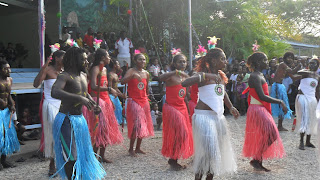The Drill Hall at the University of Papua New Guinea played host to the 6th anniversary celebration of the Autonomous region of Bougainville Day, Sunday 10th July 2011. An occasion that occurs annually for the past six years, the day was marked as a day of peace and prosperity for all Bougainvilleas.
With the theme: 'Progress through Peace and Unity', the Drill Hall was packed to capacity as Bougainvilleas from all around Port Moresby City made their way to witness this event. Friends and wantoks from across the nation have also turned up to show their support and join in the celebration.
A fee of K2 was paid at the gate for adults and K1 for children for entry, all proceedings go towards the Bougainvillea Awareness Program. A sea of dark coloured people filled the Drill Hall grounds with a few people from outside provinces bear witness to this splendid event. The day was filled with fun and excitement, smiles all around as everyone was having a great time.
The Bougainvillea Day committee prepared a series of jam-packed performances to keep the crown on its feet. Dancers, mainly student from around the city preformed in their own traditional way and costume (bilas). There were performances from all across the great region of Bougainville, capturing the crowd with their own unique styles and identity. Their colour and vibrant attire brought the stage alive.
The world famous Bamboo band also played for the crowd by young skilful youths from the Autonomous Region. The beating of the hollow bamboo sets sent out an electric wave of melody that ignited the atmosphere. Choirs of singers sang beautifully in their own dialect while the PNG famous Kundu drums beat on. A performance of live Bougainvillea band also played affecting everyone through the massive sound system.
Many youths painted their faces with the flag of Bougainville while other absorbed as much culture as they can. Various schools from around the city such as Tokarara Secondary School took part in the Day by performing a local dance.
Many groups preformed dancers and plays. One after the other, the crowed was kept entertained. Many tourists were also there to witness this occasion and take pictures.
The event tasted even more delicious when lunch was prepared and free of charge. Each three regions of Bougainville cooked a traditional styled local food for everyone to enjoy at no cost.
This day was made possible by its major sponsors; the President of the Autonomous Bougainville Government Hon. John Momis, Member for South Bougainville Hon. Steven Pirika Kama, Pest Control Company and PNG Power Ltd, all of whom were present at this occasion.
The Bougainville Student Association of the University of Papua New Guinea along with its organising team put together a wonderful event with the UPNG students performing the final performance, a local dance to the beat of locally produced music that had the crowd roaring.
Info: The Autonomous Region of Bougainville
Bougainville is an island located east of Papua New Guinea, in the south-western Pacific Ocean, largest of the Solomon Islands. Together with Buka Island and other nearby smaller islands it forms the province of North Solomons also known Bougainville Province. The population of the province is 175,160 (2000 census), which includes the adjacent island of Buka and assorted outlying islands including the Carterets. Although Bougainville Island is geographically part of the Solomon Islands archipelago, the nation of the Solomon Islands is a separate state.
Bougainville is wooded and mountainous; its highest peak is an active volcano. Arawa is the largest community; the population of North Solomons Province (1990 estimate) is 159,500. From Kieta, the principal harbour, cacao, copra, and copper are exported.
The Bougainvilleas are a very unique and rare group of people in this Melanesian society, they have a darker skin pigmentation compared to the other pacific island nations which makes them stand out as a rare gem in a sea of sand.
By Cassidey Paiyala - UPNG Student.







No comments:
Post a Comment